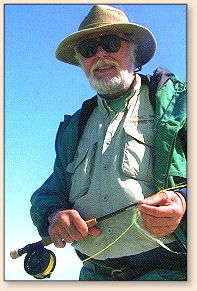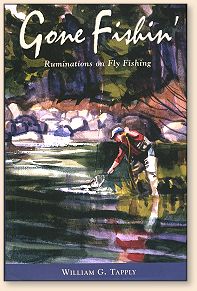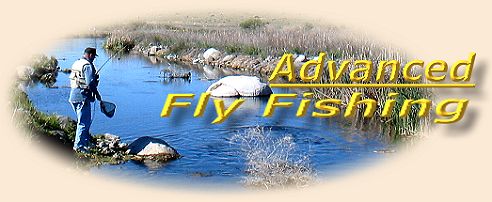|
In the 1971 edition of James E. Leisenring's
1941 classic The Art of Tying the Wet Fly,
Vernon S. Hidy added a few chapters in which he
introduced the angling world to the flymph. Half
nymph and half wet fly, the flymph imitated "that
dramatic and little-understood interval of an aquatic
insect's life: the struggle up to the surface as well
as the drift (of some insects) in or just below the
surface film."
The term "flymph" passed out of our angling lexicon
without ever really catching on. But Hidy's astute
identification of this important stage of the insect's
life cycle which we now call the "emerger" sparked a
booming little industry of specialized fly patterns
and angling strategies.
The fly that Hidy used to imitate the flymph was a
simple, wingless hackled fly. Nowadays it's called a
"soft-hackled wet fly," although that's something of
a misnomer. Anglers who fish with the Soft Hackle
these days generally tie it and use it as an attractor
pattern rather than to imitate an emerger (although
the trout might think differently when they see it).
Hidy's flymph is basically a soft-hackle wet fly
tied in sizes, shapes, and colors to match the
insects that are in and on the water. As he described
it, the flymph is "a wingless artificial fly with a
soft, translucent body of fur or wool which blends
with the undercolor of the tying silk when wet,
utilizing soft hackle fibers easily activated by
the currents to give the effect of an insect alive
in the water."
The flymph, and the method Hidy used to fish it,
imitated the emerger. He advised anglers to cast
"upstream or across for the trout to take just
below or within a few inches of the surface film ...
to simulate the hatching nymphs of the mayfly, caddis
fly, or other aquatic insects as they struggle up
toward the surface or drift momentarily in or just
under the surface film."
Despite all the attention that emergers and their
imitations have received in the past few decades,
references to the soft-hackle (or the flymph) as
an effective imitation are rare. For example, Doug
Swisher and Carl Richards, in their important book
Emergers (1991), provide an encyclopedia
of lore on this stage of the insect's life. The
authors give recipes and tying instructions for
dozens of emerger patterns and never even mention
the Soft Hackle or the flymph or Vernon S. Hidy.
If the flymph were merely an historical oddity,
Swisher and Richards might be excused. But flymphs
work. In my experience, in fact, they usually work
better than the fancier (and fussier-to-tie) emerger
imitations that Swisher and Richards and others have
invented.
Flymphs catch fish throughout the various stages of
the hatch, when nymphs first begin to rise to the top
of the water, when the half-hatched insects drift in
and just under the surface film, -when duns (and cripples
and stillborns) float on the water, and even when spent
and dying spinners ride the downstream currents.
In the first stage of the emergence, mayfly
nymphs, caddis, and midge pupae break away from the
river bottom and begin to swim toward the surface,
sometimes quite rapidly. Their legs and gills pulsate
and vibrate with their efforts. Many never reach the
surface, because nearby trout, whose appetites are
activated by the appearance of the nymphs, gobble them.
Dead-drifted nymph or pupa imitations will take some
of these trout. But a flymph, fished to imitate the
behavior of the insects, works better. "Big Jim"
Leisenring specialized in catching these trout with
wet flies. Although he didn't call the wet flies he
used "flymphs" (his friend Vernon Hidy hadn't yet
coined the term in 1941), Leisenring preferred wingless,
soft-hackled wet flies. "I could always, and still can,
catch more fish on a wingless imitation," he wrote.
He cast his flymph upstream of a feeding trout,
let it sink to the bottom and drift toward the
fish, and as it came within the trout's vision,
he "made it to appear alive and escaping" by
stopping his rod, which had been following the
progress of the fly, causing the fly to rise
toward the surface. "The pressure of the water
against the stationary line and leader," he wrote,
". . . causes the fly to rise slowly, opening and
shutting the hackles, giving a breathing effect
such as a genuine insect would have when leaving
the bottom of the stream to come to the surface."
When the nymphs or pupae are near the surface
but have not yet begun to metamorphose into duns,
the classic tight-line, down-and-across wet-fly
swing can be deadly. Fish your flymph this way
and trout will hit it violently. The challenge
is to avoid having your rod yanked from your hand
or snapping your leader. Steer the nymph to the
fish with your rod raised and be ready. The strike
is usually visible a splash or bulge or quick flash
in the water and when you see it, you should instantly
lower your rod. The tension of the line in the water
will cause the trout to hook himself.
The flymph is absolutely deadly during that
time when the nymphs or pupae have reached the
surface and are struggling to extricate themselves
from their shucks. This is the stage that Hidy
specifically targeted with the flymph. He called
them "nymphs-about-to-be-born-into-flies" what
we now call "emergers." They drift in or just
under the surface film, and with their desperately
wiggling legs, their writhing bodies, their bursting
wingcases, and their split and dangling shucks, they
are shapeless and messy and vulnerable, and no two
of them look precisely alike. For this stage, elegant
and precise emerger patterns might imitate ten percent
of the insects that are in the water. But the suggestive
flymph, in the right size and color, represents them all.
You can determine whether this mid-stage insect
is on top of the water or trapped in the film or
drifting an inch or two under it by studying the
riseforms of the feeding trout. Bulges and
head-and-shoulder rises mean that they're taking
insects beneath the surface. A flymph, fished on a
fine tippet and a floating line, will naturally drift
at this level.
When trout leave a bubble on the surface, it's
likely they're eating floating emergers. Blow your
flymph dry and dress it with dry-fly floatant, and
it will drift low on the surface film where these
trout are feeding.
Whether they're eating off the top or just under
the surface, fish the flymph as you would a dry fly.
Cast it upstream of a feeding trout and let it
dead-drift over him or fish it down-and-across with
a reach cast. In either case, the water will cause
the hackles to pulsate in a lifelike manner, although
adding a slight twitch as the fly approaches a cautious
fish might help him to make up his mind.
When the trout start eating the fully hatched
insects that are drifting on tippy-toes on the surface,
it's time to switch to a dry fly, right? Well, sure.
But if those trout are picky as they so often are the
flymph can be your problem-solver. Even when they're
feeding selectively on floaters, trout can't resist
a cripple or a straggling, incompletely hatched nymph
or pupa. These insects, trout seem to sense, won't
suddenly fly off the way healthy, fully hatched duns
and adults tend to do. A flymph in the right color
and size, dressed with floatant and fished with a
dead drift in the film, has rescued me from many
frustrating situations when the trout ignored
my high-floating dry fly.
Trout can be agonizingly selective when they're
picking off spent, lifeless spinners. They eat spinners
leisurely, knowing that they're not going anywhere, and
they take their time to study them. Perfect imitations,
cast precisely and fished with no drag whatsoever,
will usually catch at least a few of them.
Surprisingly, the suggestive flymph often works
better. Fished on the surface, perhaps the flymph
suggests a mangled, broken-winged spinner. Trout
are always suckers for cripples, even dead ones.
Fished an inch or so under the surface, the flymph
probably represents a spinner that has been churned
and tumbled in the riffles, lost its surface tension,
and sunk.
I like the term "flymph" to distinguish these
flies from attractor wet flies, both winged and
wingless, and from generic Soft Hackles. Flymphs
are not complicated to tie. A few wisps of hackle
fibers for a tail, a dubbed body, a gold rib, and
a couple turns of hackle, that's all. But remember:
Flymphs are intended to imitate specific insects
and they should be tied with that in mind.
The key to precise imitation is the insect's body.
"My experience has taught me," Leisenring wrote,
"that bodies of artificial flies are most deadly
when, in addition to color, they imitate the texture,
translucence, and flash of the natural fly as nearly
as possible."
For example, if you're fishing the early stage
of a blue-winged olive hatch, when those little
dark nymphs are darting and wiggling toward the
surface, a properly sized flymph with a
pheasant-tail body and a fine gold rib does
the job. Later in the emergence, when the
naturals have broken out of their nymphal shucks,
switch to a dubbed-body flymph the color of the dun.
For the right shape and translucence, dub your
flymph bodies sparsely and make them slender. A
fine gold or copper rib gives some flash and
suggests the segmentation of the natural insect.
Mayfly emergers come with tails and so should
your flymphs. Caddis and midge pupae have no
tails, of course.
For most situations, the best hackles for a flymph
are the breast and side feathers from a game bird
such as a grouse or a woodcock. These are the
feathers that gave the Soft Hackle its name. Strip
the fibers off one side of the feather and tie it
in by the tip with the shiny side facing forward.
For flies sizes 16 and smaller, wind it just two
turns around the front of the fly. For larger flies,
three or four turns give the flymph proper balance.
For fishing a flymph with a "Leisenring lift"
or across-and-down on a tight line, hackles
stiffer than those from game birds work better.
The soft hackles tend to collapse around the fly,
reducing its lifelike appearance. Carry a selection
of flymphs tied with stiffer hen and cock hackles
for these situations.
"Future anglers,"Vernon Hidy wrote in 19711, "may
well consider the three-dimensional flymph technique
as more exciting than the dry since it requires a
keener observation, greater finesse, and a more
delicate touch at the fly-tying table and on the
stream."
Hidy was right and he was wrong about us "future
anglers." Most of us have incorporated into our
arsenal of trout tactics his wisdom about the
important emerger stage in the life of aquatic
insects. But few of us remember the word he
coined for it or the fly he used to imitate it.
It's time we reconsidered the flymph. ~ WGT

About William G. Tapply:
William G. Tapply is the author of more than thirty
books, among them twenty-one New England-based
Brady Coyne mystery novels. Tapply has written several books
about fly fishing and the outdoors, including Pocket
Water and Bass Bug Fishing. He is a
contributing editor for Field & Stream, a columnist
for American Angler, and has written hundreds of
articles and essays on a variety of subjects for dozens of
others publications.
 Tapply is a professor of English at Clark University in
Worchester, Massachusetts, where he teaches writing.
He lives in Hancock, New Hampshire, with novelist
Vicki Stiefel, his wife, and Burt, his Brittany
spaniel.
Tapply is a professor of English at Clark University in
Worchester, Massachusetts, where he teaches writing.
He lives in Hancock, New Hampshire, with novelist
Vicki Stiefel, his wife, and Burt, his Brittany
spaniel.
The above article is an excerpt from Gone
Fishing, published by Lyons Press. We
sincerely appreciate the gracious permission of the
author to re-publish it here.
|



 Tapply is a professor of English at Clark University in
Worchester, Massachusetts, where he teaches writing.
He lives in Hancock, New Hampshire, with novelist
Vicki Stiefel, his wife, and Burt, his Brittany
spaniel.
Tapply is a professor of English at Clark University in
Worchester, Massachusetts, where he teaches writing.
He lives in Hancock, New Hampshire, with novelist
Vicki Stiefel, his wife, and Burt, his Brittany
spaniel.